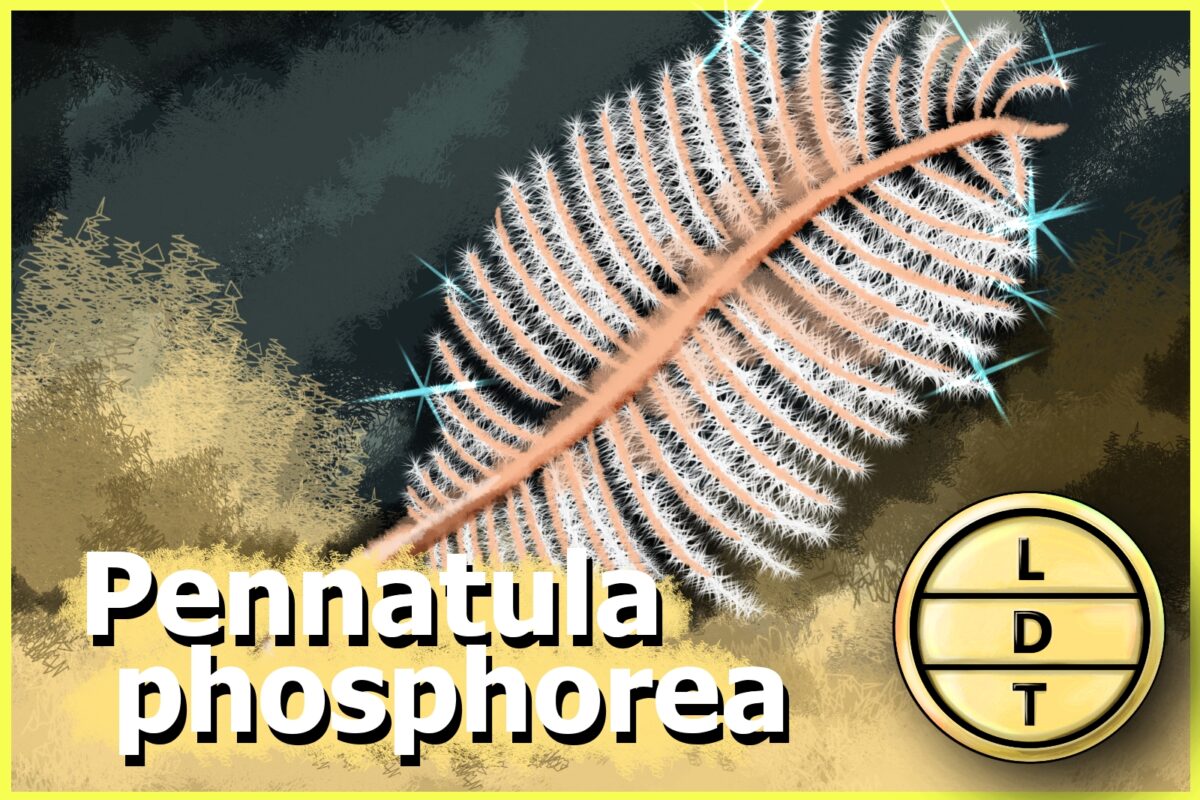“…and today we’re talking about the plume in the room. But more on that later.”
At the bottom of the deepest oceanic trench, you’ll find an animal that’s worth writing home about. The sea pen is a feathery friend with multiple personalities and penchant for puffing itself up when the coast is clear. But when slow-moving danger is around every corner, you have to be ready to retreat here in Life, Death, and Taxonomy.
Description
- The sea pen is so named because it sort of looks like a feather pen.
- The feathers are actually tentacle-like appendages
- A smooth bulb anchors the sea pen in the sediment and a stock rises and curls like a fancy quill.
- Branches from the quill have tentacles that give the organism a feathery appearance.
- They come in a variety of light colors from a cream color to pink.
Measure Up
Welcome to the beloved Measure Up segment. The official listener’s favorite part of the show! The part of the show when we present the animal’s size and dimension in relatable terms through a quiz that’s fun for the whole family. It’s also the part of the show that’s introduced by you when you send in audio of yourself saying, singing, or chittering the words Measure Up into ldtaxonomy at gmail dot com. We do have a Measure Up intro this week from our friend Calvin.
Length at Sexual Maturity
- 55 and 90 mm
- How many sea pens go into the length of the longest feather ever recorded?
- Hint: According to Guinness, the longest feather ever recorded was documented in 1972 in Kochi, Shikoku, Japan. The feather belonged to a phoenix fowl, also called a yokohama chicken.
- 117.7 sea pens. The feather was 10.6 m (34 ft 9.5 in).
Living depth
- 6,100 m (3.7 miles)
- How many sea pen living depths would go into the length of RNA needed to vaccinate the entire world?
- Hint: This came from the subreddit r/theydidthemath, which I found because we’re mentioned in the comments for our measurement-based assault on mathematics. Thanks to listener Jessica for emailing to let me know that were mentioned on at least one corner of Reddit.
- 49,709,695,400,000 depths. It would take 296 trillion km (31 light years) of RNA.
Fast Facts
Though sea pens look like plants, they live down where no plants can survive because of a lack of sunlight. They can live in shallow reef areas to deep intertidal abysses.
They like all kinds of regions but prefer tropical and temperate water.
The entire order pennatulacea are called sea pens but only members of subselliflorae really look like feather pens. Other orders can be found in a variety of fanciful shapes from feather dusters to peacock plumage.
The fully unfurled plume is actually full of water and it can deflate like a broken arm flailing inflatable tube man. When there’s danger around, the pen will expel water to shrink down into the sand.
This particular genus has several bioluminescent species.
Some species of sea pens can use barbed nematocysts to sting and harpoon prey.
Also, sea pens could possibly live for more than a century. Their tentacles also have stingers. They can get up to almost 6.6 ft.
Major Fact: We are Legion
I was going to talk about the fact that the sea pen is the only non-extinct animal with glide reflection symmetry, but it turns out that it involves Euclidean geometry so it’s tough to explain. Basically, it means that the pen is symmetrical, but slightly askew so it’s not symmetrical at all.
Instead, let’s talk about polyps. You may have noticed that the sub class was “octocorallia”, which is octocorals.
So the sea pen has more in common with coral than anything else.
Each polyp is basically a tiny jellyfish octopus – a cnidarian with eight tentacles that all come together to form a single animal.
The first polyp will lose its tentacles and turn into the tree trunk of the pen with a large root at the bottom (otherwise known as the peduncle) and anchoring itself in the sea floor.
Then other polyps bud from it and each one specializes in a different function. Like pluripotent cells.
Some polyps become gills, others become rudimentary stomachs, and others become reproductive organs. Like a more advanced version of three kids wearing a big trenchcoat to get into a PG-13 rated movie.
When you see a sea pen in its full glory, it’s actually mostly filled with water. If it’s threatened, it can expel that water and deflate, disappearing into the sand. This process can take up to 4 hours, but when your primary predators are sea slugs and star fish, you have time.
Ending: So anchor yourself, work on your Euclidean reflection geometry, and remember that the pen is mightier than the swordfish here in LDT.

